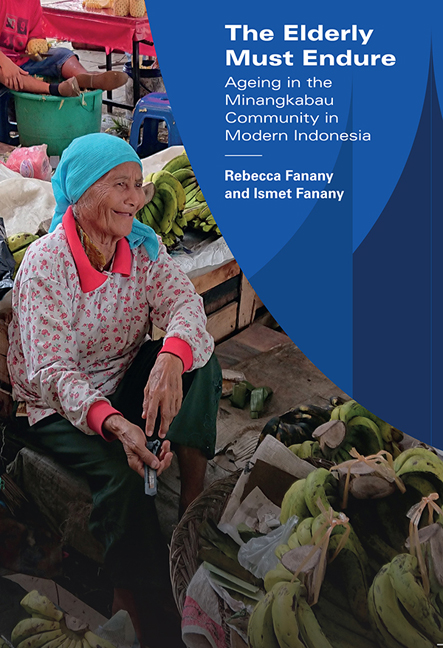Book contents
- Frontmatter
- Contents
- Acknowledgements
- Map of Indonesia
- Map of West Sumatra
- Map of the Village of Koto
- Aminah's Family Tree
- 1 Introduction
- 2 Ageing in the Past and Present
- 3 Adat Traditions and the Elderly
- 4 Religion and the Elderly
- 5 Language and the Elderly
- 6 Ageing in the Village
- 7 Ageing in Padang
- 8 Ageing in the Rantau
- 9 Ageing in an Institution
- 10 Ageing and Cultural Consonance
- 11 The Elderly Must Endure
- Afterword
- References
- Index
- About the Authors
7 - Ageing in Padang
Published online by Cambridge University Press: 16 May 2019
- Frontmatter
- Contents
- Acknowledgements
- Map of Indonesia
- Map of West Sumatra
- Map of the Village of Koto
- Aminah's Family Tree
- 1 Introduction
- 2 Ageing in the Past and Present
- 3 Adat Traditions and the Elderly
- 4 Religion and the Elderly
- 5 Language and the Elderly
- 6 Ageing in the Village
- 7 Ageing in Padang
- 8 Ageing in the Rantau
- 9 Ageing in an Institution
- 10 Ageing and Cultural Consonance
- 11 The Elderly Must Endure
- Afterword
- References
- Index
- About the Authors
Summary
PADANG AND THE TRADITIONAL RANTAU
In the traditional Minangkabau conceptualization of place, the city of Padang, which is now the capital of the Indonesian province of West Sumatra, was seen as the rantau. Because folklore holds that the Minangkabau originated in the mountainous interior of the region, marantau included a spreading out in all directions, first to closer areas outside this heartland and later to more distant locations. The Minangkabau world, then, at least as it in depicted in folklore and traditional conceptualizations, consists of a set of concentric rings with the three original regions (luhak) of Tanah Datar (where Koto is located), Agam, and Lima Puluh Kota at the centre. The oldest traces of Minangkabau civilization can be found in these regions, and the traditional home of the royal family was in the village of Pagaruyung in Tanah Datar, not far from the town of Batusangkar and the village of Koto. Conceptually, if not literally, all Minangkabau are said to have had their origins in one of the three original luhak, even if they went to other areas in the distant past.
The oldest rantau areas were those places closest to this cultural heartland and are located within a few days travel on foot. They include the coastal areas of West Sumatra, where Padang is located, as well as cities and towns in neighbouring provinces. It is believed that Minangkabau going to the rantau first reached the Jambi region in the seventh century. These early travellers set themselves up as goldsmiths, a traditional profession in an area of Agam near Bukittinggi (Munoz 2006). Other parts of Sumatra that are farther away were reached by Minangkabau settlers later. By the fourteenth century, there were colonies of Minangkabau living permanently in Sibolga and Natal in North Sumatra, Meulaboh in Aceh, Bengkulu, Lampung, as well as in Negeri Sembilan in Malaysia (Dobbin 1983). In time, people of Minangkabau heritage came to dominate the population in Negeri Sembilan, and Minangkabau cultural elements are still visible in the community, which has become part of the Malay mainstream (Peletz 1994). By the sixteenth century, large numbers of Minangkabau were living in towns on the island of Sulawesi, where, in addition to trading, many became religious leaders and teachers (Mukhlis et al. 1995).
- Type
- Chapter
- Information
- The Elderly Must EndureAgeing in the Minangkabau Community in Modern Indonesia, pp. 140 - 170Publisher: ISEAS–Yusof Ishak InstitutePrint publication year: 2018



